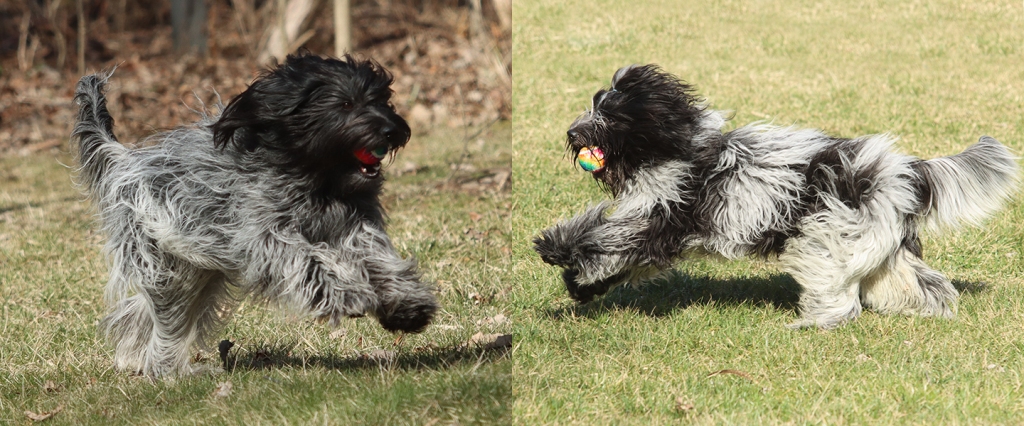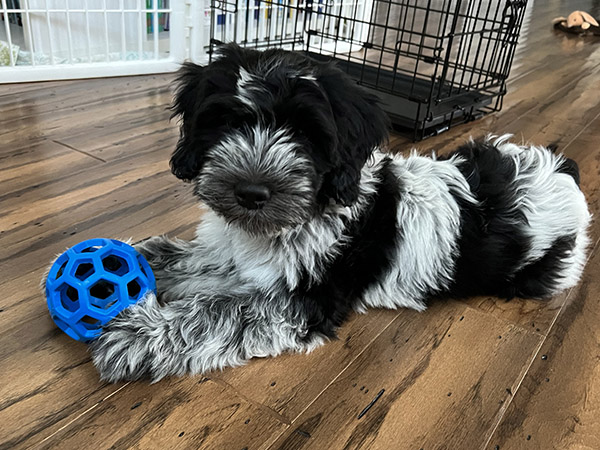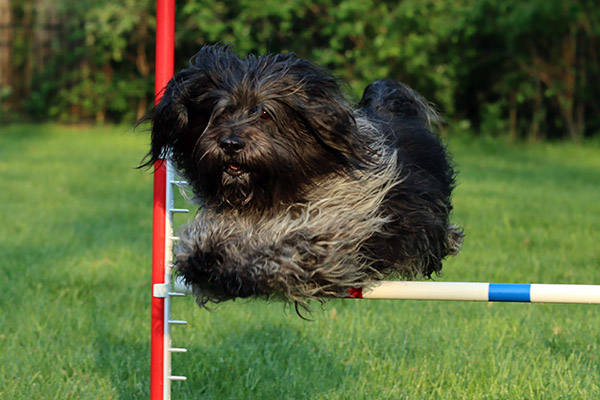Bubbles became the FIRST Schapendoes to earn the AKC Certificate of Merit in Conformation on February 1, 2024. The CM title is the FSS equivalent of the CH title. Proud of my homegrown girl UKC CH Dreamstar’s Powerpuff Girl CM MX MXJ OF DCAT CGC

Bubbles became the FIRST Schapendoes to earn the AKC Certificate of Merit in Conformation on February 1, 2024. The CM title is the FSS equivalent of the CH title. Proud of my homegrown girl UKC CH Dreamstar’s Powerpuff Girl CM MX MXJ OF DCAT CGC

We hope to breed Bubbles to Teddy sometime in 2024. We expect to get some fun little performance dogs. Stay tuned for updates!

Dream Star Schapendoes & Wild Clover Schapendoes are excited to welcome home our new puppy boy from France!






Meet “Teddy” Royal Balin’s The Feeling is Mutual
Feeling du Jardin des Lucioles HU-TUR-AZ-SM-CY-PAK-SL-PHL-MAL-COL-CHI–TW-CR-URK-GEO-MOL-BUL-LUX-INT-Champion x N’Arwen du Royaume de Fanelia JVDH FCNAT EW19 IB A FCS
Teddy was the best puppy boy ever on his trip home!
His breeder Nathalie of Royal Balin’s met me in Paris and spent 2 days with us sight-seeing so Teddy could get to know me before our long trip across the pond. Teddy was quiet in his bag at my feet for the entire flight from Paris to Newark. Marita’s husband Al was nice enough to pick us up from the airport so we could visit Marita, Trinje, and Gullin. They took great care of us, so we were rested for our flight back to Indy.
Bubbles, Dreamstar’s Powerpuff Girl, was thrilled to meet her new friend Teddy. He must be a charmer. Shady thinks he fine too and she normally avoids all puppies.
On Tuesday July 6th, 2021, eight Schapendoes puppies were welcomed into the world.
Meet Zing’s Summer Pool Party Litter!









Zing’s due date based on progesterone and LH testing at the time of breeding is July 6, 2021. Last litter was born at 62 days which would be July 5th. We are excited to meet the puppies!
Trinje’s owners made the long drive from New Jersey to Indiana. The breeding took place on Thursday via side by side TCI (Trans Cervical Insemination). All the experts agree the timing was perfect based on the progesterone and LH testing. We will do an ultrasound the end of May to confirm the pregnancy. Puppies will be due on July 5th!





We are excited to announce our plan to repeat the breeding between Zing & Trinje this spring 2021. Puppies will be ready for new homes sometime late summer or early fall 2021.


A friend suggested a Schapendoes for me ten years ago. I was looking for a family pet that would also enjoy dog sports. Long coated breeds always appealed to me, having owned a Lhasa apso, Shih Tzu, Lowchen, and Soft Coated Wheaten Terriers. The medium size, friendly temperament, and good jumping ability in the Schapendoes breed standard sounded ideal. As a small animal veterinarian, I appreciate the good health of breeds with no extreme features. As a mom, I appreciate a nice, stable temperament. The Schapendoes breed had it all. My research on the breed had just begun, with the plan of getting a puppy in a year or two, when I stumbled upon a rare US born litter of three week old Schapendoes. I visited the puppies with no intention of bringing one home. The instant I arrived at the breeder’s house and was greeted by four adult Schapendoes, I knew I would be leaving with a puppy. They were the perfect size dogs and they were so very friendly and welcoming.
DUTCH SCHAPENDOES (Nederlandse Schapendoes)
TRANSLATION : Mrs Chris Seidler.
ORIGIN : Netherlands.
DATE OF PUBLICATION OF THE OFFICIAL VALID STANDARD : 26.03.1992.
UTILIZATION : The Nederlandse Schapendoes is a herding dog which was used for herding flocks of sheep and which is still used in the same capacity today. As pasture for sheep is situated mainly in quiet, lonely areas of the country, it is necessary for the Schapendoes to be equipped with great endurance, mobility and speed. A great facility for jumping is essential, as well as intelligence and the ability to act on his own. He has to be a true herding dog in character, body and soul.
CLASSIFICATION F.C.I. : Group 1 Sheepdogs and Cattledogs (except Swiss cattledogs). Section 1 Sheepdogs. Without working trial.
BRIEF HISTORICAL SUMMARY : At the end of the last and beginning of this century, the Nederlandse Schapendoes occurred everywhere in the region of the Netherlands where there was heathland and where there were herds or flocks of sheep. The shepherds valued him for the tireless pleasure he took in his work and for his intelligence. He belongs to the wide-ranging group of long-haired herding breeds which have densely coated heads. He is related to the Bearded Collie, the Puli, the Owczarek Nizinny, the Bobtail, the Briard, the Bergamasker and the German Schafspudel of the variety which occurs in Hessen, Odenwald and the Niederrhein district. All these similar dogs are smaller mutations of mountain dogs. The canine authority, P.M.C. Toepoel, is the founder of this breed. During the second World War, he knew how to rouse interest in the breed. During the years from 1940 to 1945 specimen of the almost vanished Schapendoes were used for breeding from wherever they could be found.
The Breed Club for Nederlandse Schapendoes was founded in the year 1947 and in 1952 the breed was provisionally recognized by the Raad van Beheer. In 1954 the standard was set up and a Stud Book started. Definite recognition followed in the year 1971. Since then only registered dogs have been bred from.
GENERAL APPEARANCE : The Nederlandse Schapendoes is a lightly built, long coated dog with a height at withers of 40 to 50 cm. His movement is effortless and springy. He is remarkable jumper.
BEHAVIOUR / TEMPERAMENT : The Schapendoes is a normally and harmonically constructed herding dog with an attentive and courageous character. He is intelligent, watchful, jolly, lively, friendly and high spirited. Towards people familiar to him, he develops great affection and loyalty.
HEAD : The abundant growth of hair gives the head the appearance of loocking bigger and, in particular, broader.
This illustration does not necessarily show the ideal example of the breed
CRANIAL REGION : Skull : Almost flat with a moderate frontal furrow and strongly defined superciliary arches. It ist fairly broad in proportion to its length : the width is slightly greater than the distance between the stop and the occiput. Stop : Clearly defined but not steep.
FACIAL REGION : Nose : The bridge of the nose is placed a little lower than the line of the skull. Muzzle : The muzzle is shorter than the distance between the stop and the occiput. The foreface tapers hardly, remains deep and ends broadly, being only slightly rounded at its end. Seen from the side, with jaw closed, the lower jaw must be clearly visible. Teeth : Normally developed scissor bite. Cheeks : The zygomatic arches are strongly prominent. Eyes : The eyes are fairly large, round and set into the socket in a normal position. They are placed more to the front than the side of the head. Their colour is brown; they should not give the impression of being black. The white of the eye should only be visible when the dog looks hard to one side. The expression is open minded, honest and lively. Shape, colour and expression are very characteristic for the breed. Ears : These are set on fairly high and are neither large nor fleshy. They hang free, but not close to the head. They are amply feathered and mobile, but should not protrude beyond the outline of the skull.
NECK : The head is carried high on a strong, clean neck.
BODY : The Schapendoes is slightly longer than high. The skeleton is fine boned, pliable and elastic. Topline : Curved over a strong muscular loin. Chest : Deep. Ribs are moderately to well sprung; they reach far back. Lower lone and Belly : Not too tucked up.
TAIL : The tail is long, well coated and feathered. The manner and way in which the dog carries his tail is characteristic of the breed. In repose it hangs downwards. When trotting, the tail is carried fairly high and swings slightly curved from one side to the other. When galloping, it is stretched out straight. When jumping, the tail definitely serves as a rudder. When the dog is alert, the tail may sometimes be raised high. It should, however, never be carried stiffly over the back.
LIMBS
FOREQUARTERS : The front legs are straight and lightly boned. Good angulation of the front legs should emphasize the fore-chest. Pasterns : Springy.
HINDQUARTERS : Pelvis : In a well slanted position. Hocks : Moderately angulated, well muscled. Metatarsus : Short.
FEET : The feet are fairly large and elastic, broad and oval in shape. The toes are tightly bunched. The pads are thick and springy, with plentiful hair between them. Dewclaws are permitted.
GAIT / MOVEMENT : In his work, the Schapendoes gallops rather than trots, so his movement must be light footed and springy without excessive use of energy. He must be able to jump well and turn swiftly.
COAT
HAIR : The Schapendoes has a thick coat with sufficient undercoat. The coat is long, a good 7 cm or more in the region of the hindquarters. It is not smooth, but lightly waved. Definitely curly, frizzy hair is not permitted. The hairs grow very densely together; they are fine and dry, but above all, never silky. The coat, where it is long, is inclined to stand off in tufts, giving the Schapendoes a large girth, especially at the rear. The Schapendoes has a tremendous top knot, moustache and beard.
COLOUR : All colours are permitted. Preference is given to bluegrey to black.
SIZE : Height at withers : for dogs : 43 – 50 cm, For bitches : 40 – 47 cm.
FAULTS : Any departure from the foregoing points should be considered a fault and the seriousness with which the fault should be regarded should be in exact proportion to its degree and its effect upon the health and welfare of the dog.
DISQUALYFING FAULTS : • Aggressive or overly shy dogs. • Any dog clearly showing physical or behavioural abnormalities shall be disqualified.
N.B: • Male animals should have two apparently normal testicles fully descended into the scrotum. • Only functionally and clinically healthy dogs, with breed typical conformation, should be used for breeding.
Thanks for visiting!

We welcomed our first litter of Schapendoes puppies to the world on Easter Day 2019!
Proud parents Zing (MACH Schapannro’s N Zing) & Trinje (Almelola’s Elegast van Nust OA NAJ)

Zing competes in AKC and USDAA agility at the masters level. Trinje competes in AKC, CPE, & NADAC agility, he loves sheep herding, and he is a therapy dog for alzheimer’s patients. Both dogs have friendly and affectionate family-dog temperaments.
